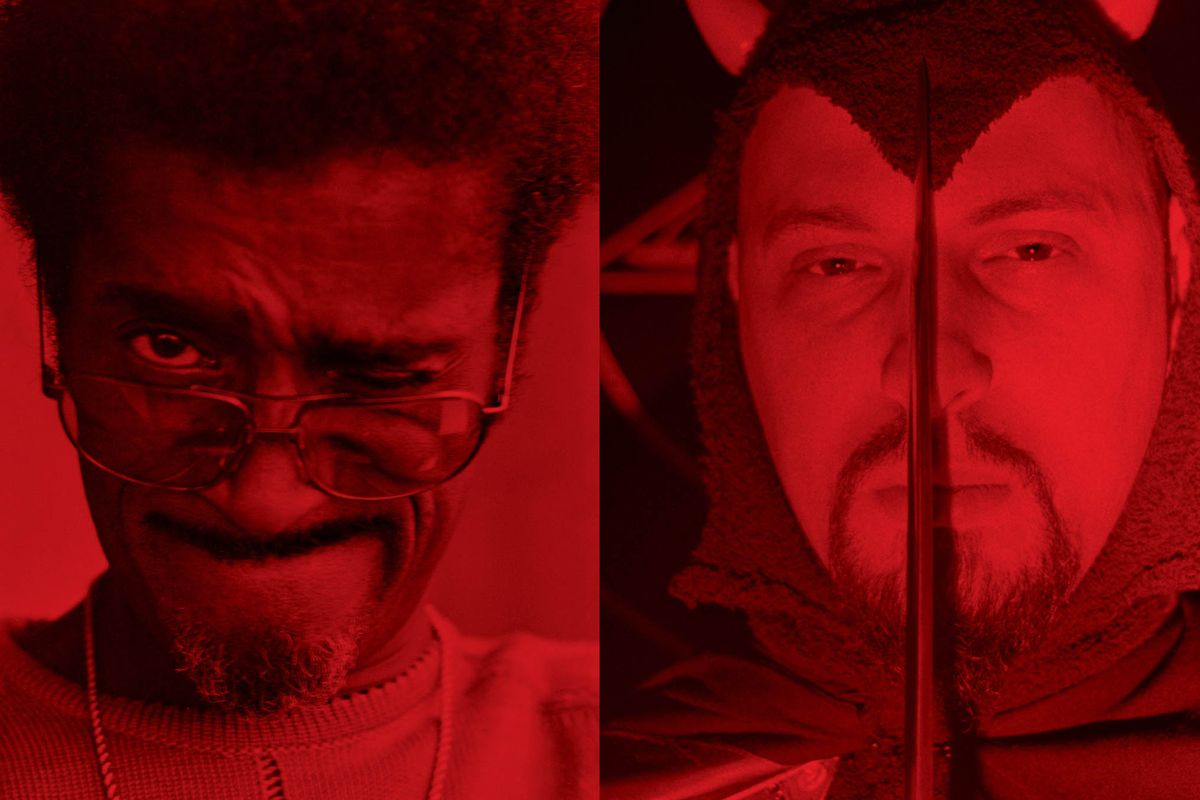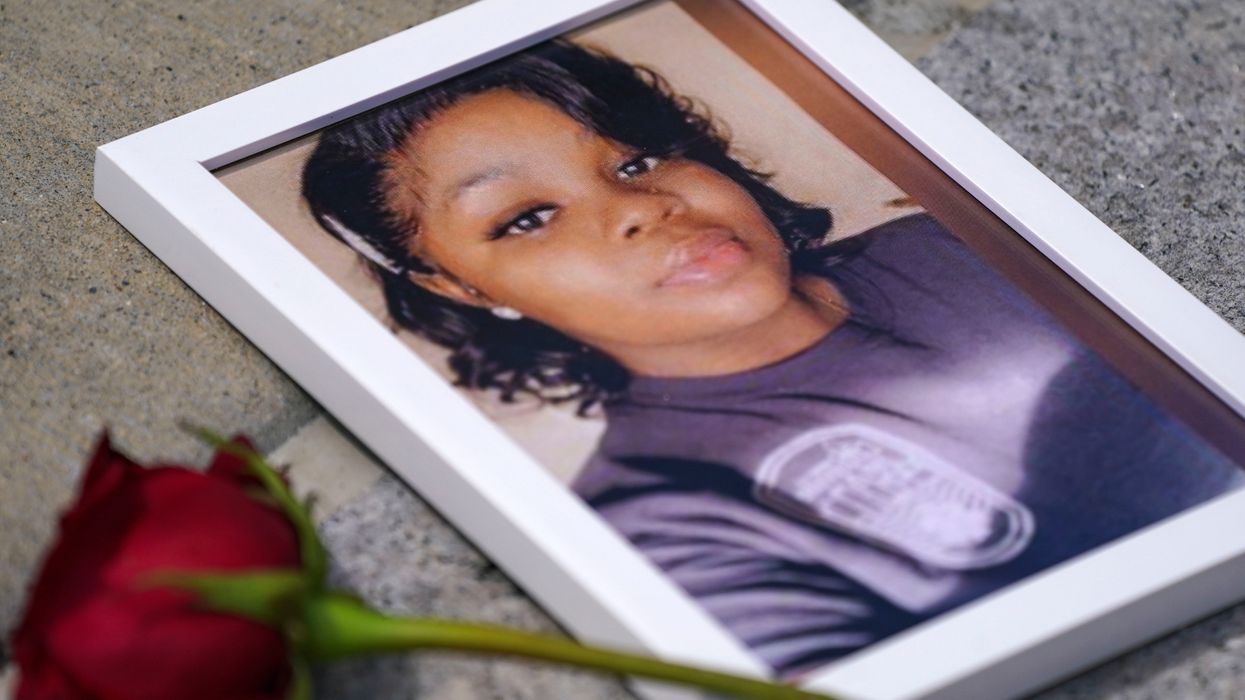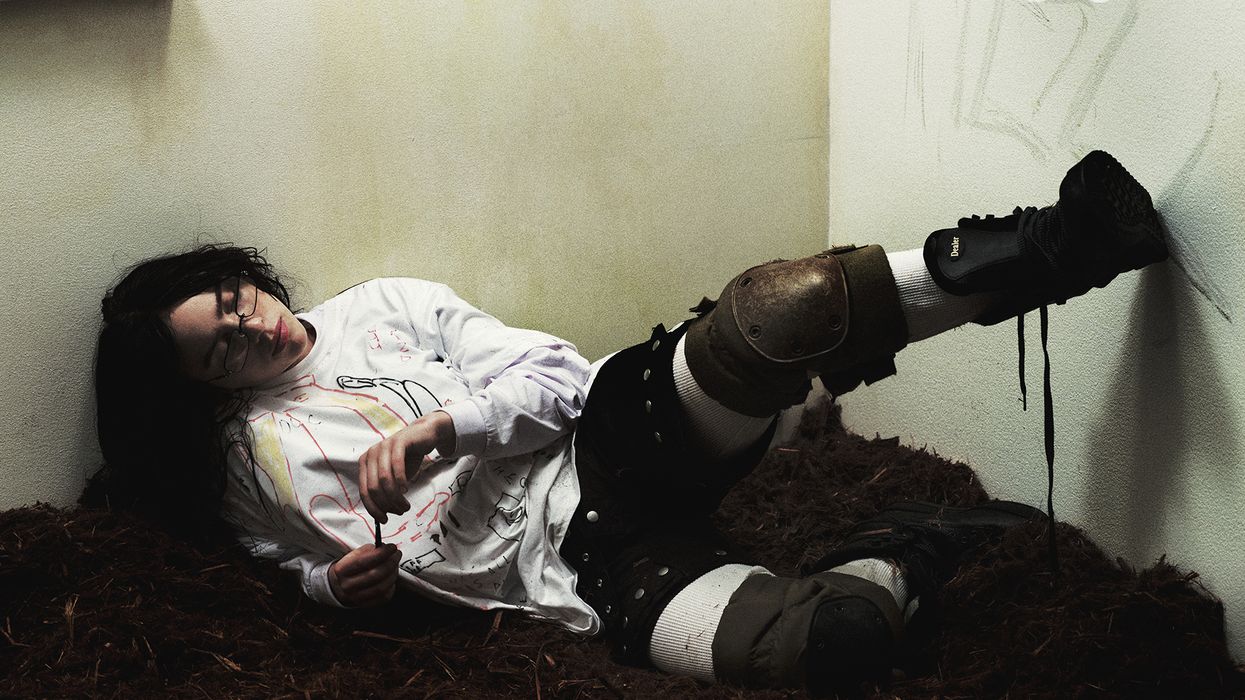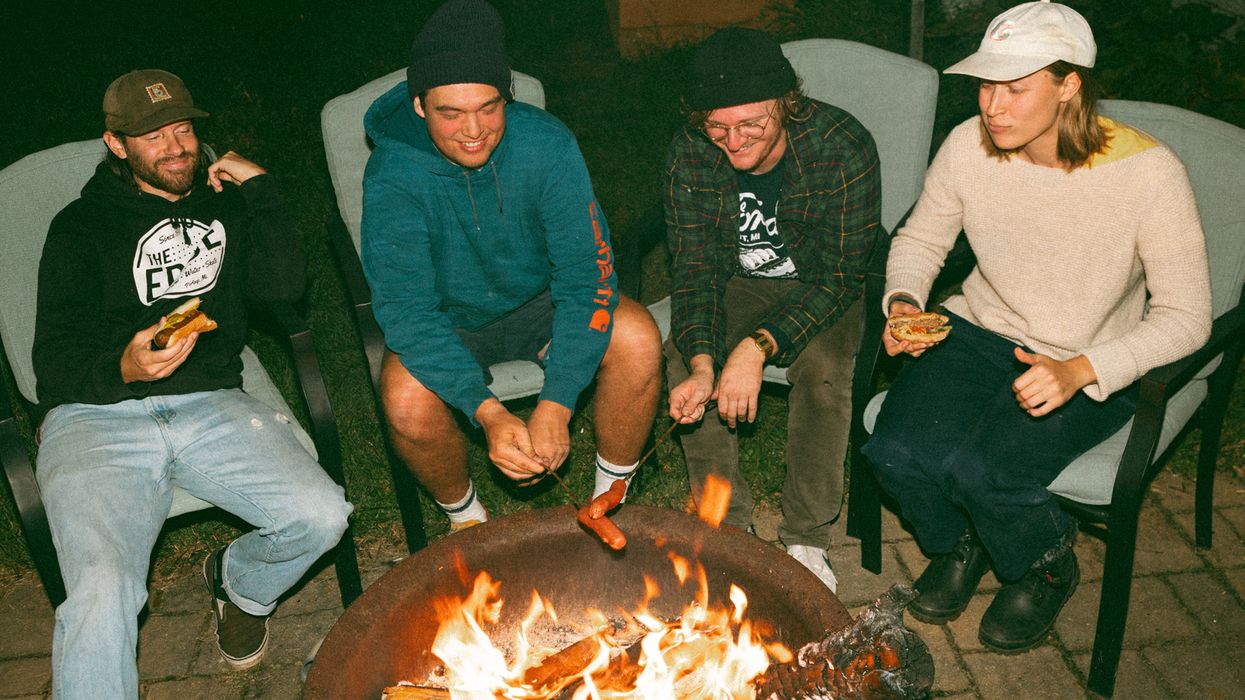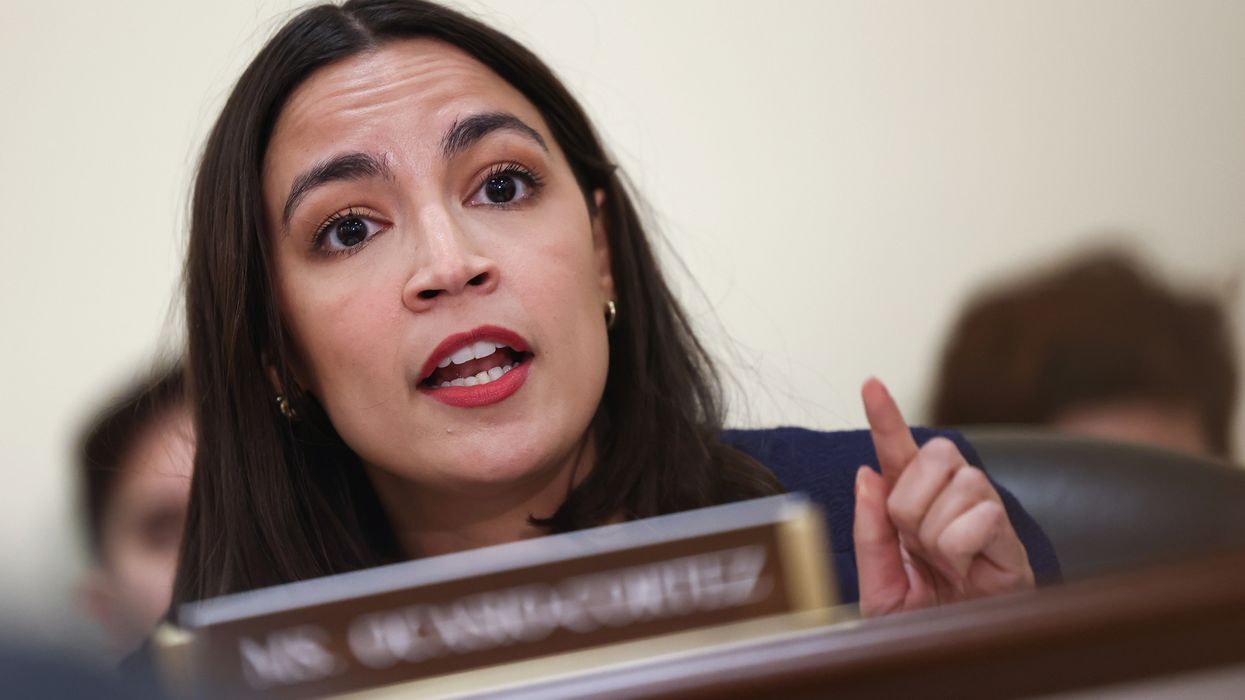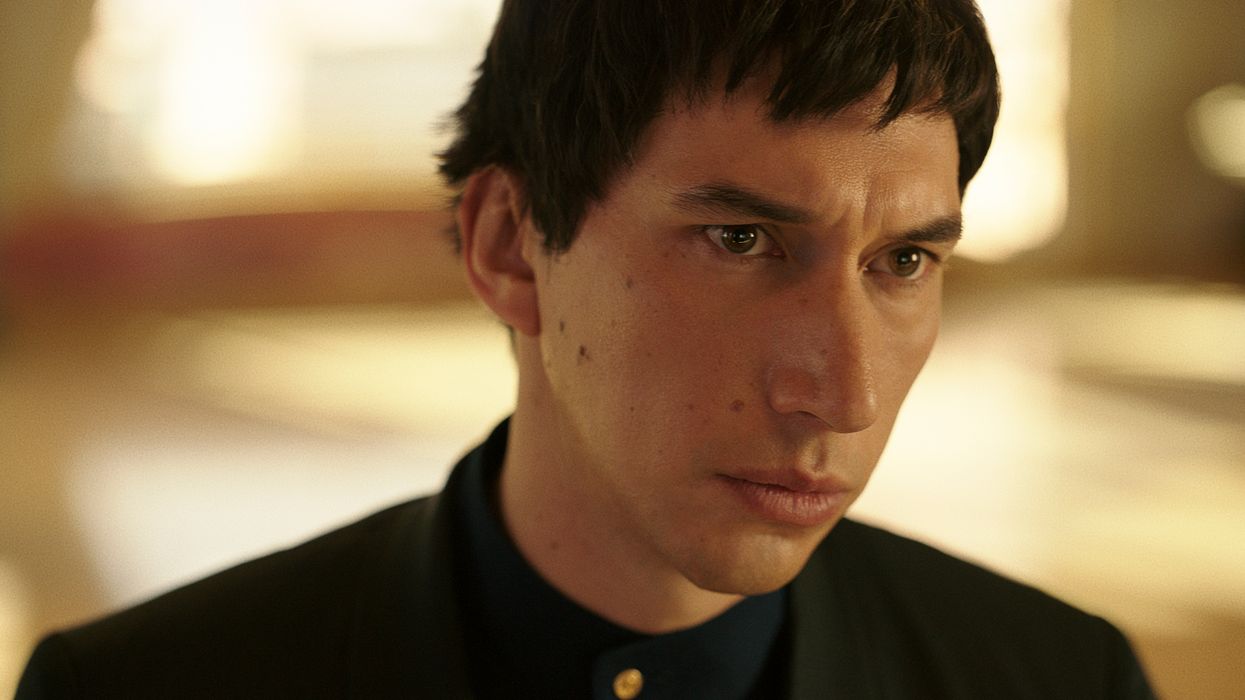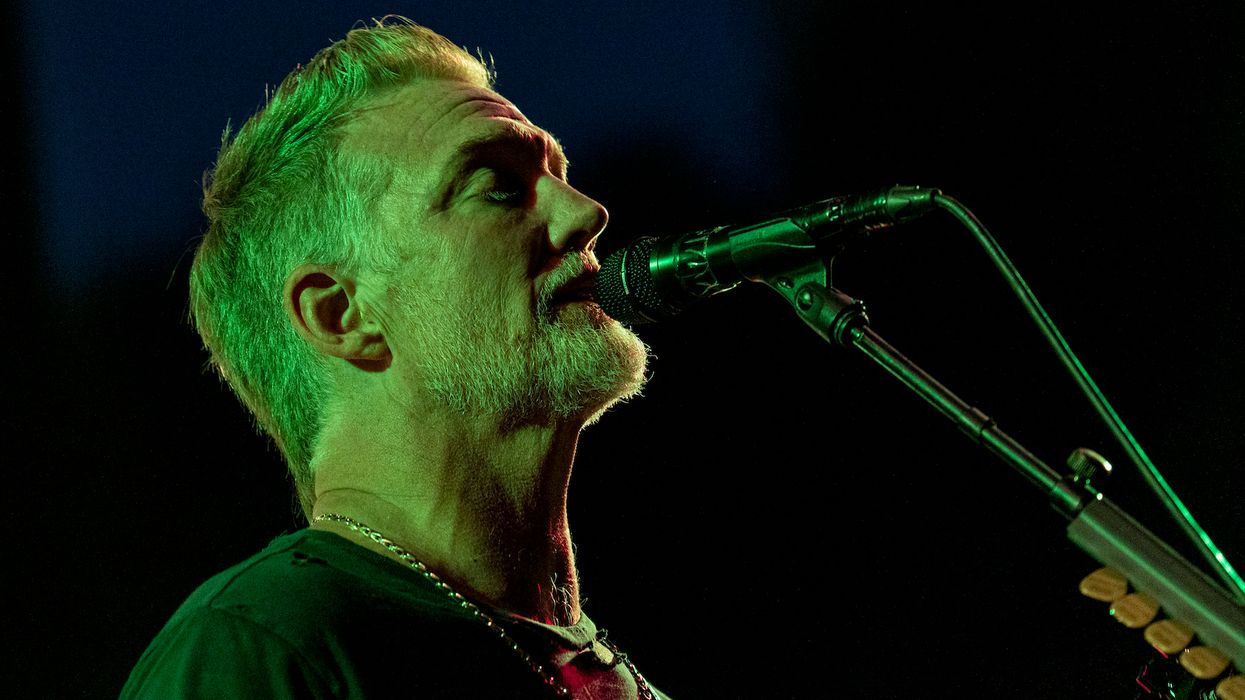The mood in hell was light. All smiles and hugs, Sammy Davis Jr. was in high spirits as he arrived at Paramount Studios in the fall of 1972 to film Poor Devil, a new NBC comedy set in the netherworld.
The 46-year-old entertainer surveyed the Hollywood soundstage, where Hades had been reimagined as a corporate office with a side of sitcom camp. Gold double doors opened to Mr. Lucifer’s office, where a stately desk sat beneath a friendly pentagram — cute horns, a dangling inverted cross for a chin. Then there was a molten cavern with an open-mouthed oven: the furnace room, where Davis’ character, a long-suffering low-level demon, has spent centuries shoveling coal.
The plot followed Sammy, as the hapless hellion is conveniently named, as he set out to prove his worth to Lucifer by convincing a mortal to sign away his soul. One line in the script — which Davis delivered with the singsong intonation of his hit “The Candy Man” — summed up his approach: “Lucifer himself says that when someone’s really desperate, that’s the time they’ll sell their soul.”
To be sure, career desperation led the most talented performer of his generation to this curious project, but so did enthusiasm. Davis later proclaimed, “I desperately wanted to do Poor Devil.” Although the project would be systematically written out of Davis’ biography and pop-culture history, the optimism seemed justified at the outset. He landed his friend Christopher Lee, Dracula himself, to play a raffish Lucifer, and lured The Odd Couple’s Jack Klugman to guest star as an accountant willing to sell his soul in exchange for sticking it to his boss, erstwhile Batman Adam West.
As production began, Davis introduced knowing Satanic details not found in the script — flashing the Devil’s horn salute and painting a fingernail red — into his performance, and screenwriter Earl Barret, also an executive producer, was encouraged, thinking the star had done his homework.
Davis seemed unwilling or unable to play Sammy as anything but a version of himself. Instead of the costume department, Davis hired his custom clothiers to create Sammy’s threads — red suit by Sy Devore and matching shirt from Nat Wise of London. And Davis made the confusion between him and his alter ego a running joke. Barret would recall giving Davis a note at one point, then clarifying, “Sorry. Sammy in the script.”
“You can stop pretending we’re different, Earl,” Davis replied, winking and nodding toward Lucifer’s office. “Stop pretending I’m not working for him.”
AS DIANE HEGARTY thumbed through TV Guide for the week of Feb. 10, 1973, one listing, a pilot for a possible series called Poor Devil, caught her eye: “Sammy Davis Jr. stars as a bumbling disciple from hell. After 1,400 years of failure to secure a single soul for Satan, the inept recruiter is given one last chance.”
At 8:30 that Wednesday evening, Hegarty switched on the TV and settled in. Halfway into the program, the accountant whose soul Davis’ character hopes to snatch is desperate to contact the little devil. Reaching for the phone in his San Francisco apartment, he exclaimed, “The Church of Satan downtown! They’ll know how to reach him!”
“I nearly fell out of my chair,” Hegarty tells me of her reaction to the scene. If the accountant had made such a call in real life, Hegarty would have answered the phone. She was, in fact, watching Poor Devil in the Church of Satan’s headquarters — a Victorian in San Francisco’s Richmond district known as the Black House, where she lived with her most uncommon common-law husband, Anton Szandor LaVey, the church’s founder and high priest. According to some familiar with the religion’s origins, Hegarty shared authorship of LaVey’s books, including The Satanic Bible, and of the Church of Satan itself. Yet it was “The Black Pope,” as LaVey was dubbed, who was the very public face of Satanism. In the pages of Life in 1967, LaVey said he hoped to have his name etched in history alongside Rasputin’s, then sat for the cover of Look magazine, grasping a skull, his eyes glowering from under his signature shaved head. He appeared on TV, dressed in robes and a horned hood, as he presided over the first Satanic wedding, the first Satanic funeral rites, and most notoriously, the first Satanic baptism, in which he anointed his and Hegarty’s three-year-old daughter, Zeena, as she sat atop an altar beside a naked woman.
For nearly seven years, such sensationalist coverage had portrayed LaVey and the Church of Satan as curiosities at best. Now, Hegarty was witnessing something wondrous on the screen before her: Here was a lovable, funny, harmless demon. Here was normalization on network TV. Satanists — they’re just like us!
Two days later, Hegarty received a letter from LaVey’s right hand, Michael Aquino, a highly decorated Green Beret, in which he gushed about Poor Devil, calling it “a magnificent commercial for the church.” Hegarty replied echoing Aquino’s enthusiasm: “I don’t think its message was far afield from what we believe.”
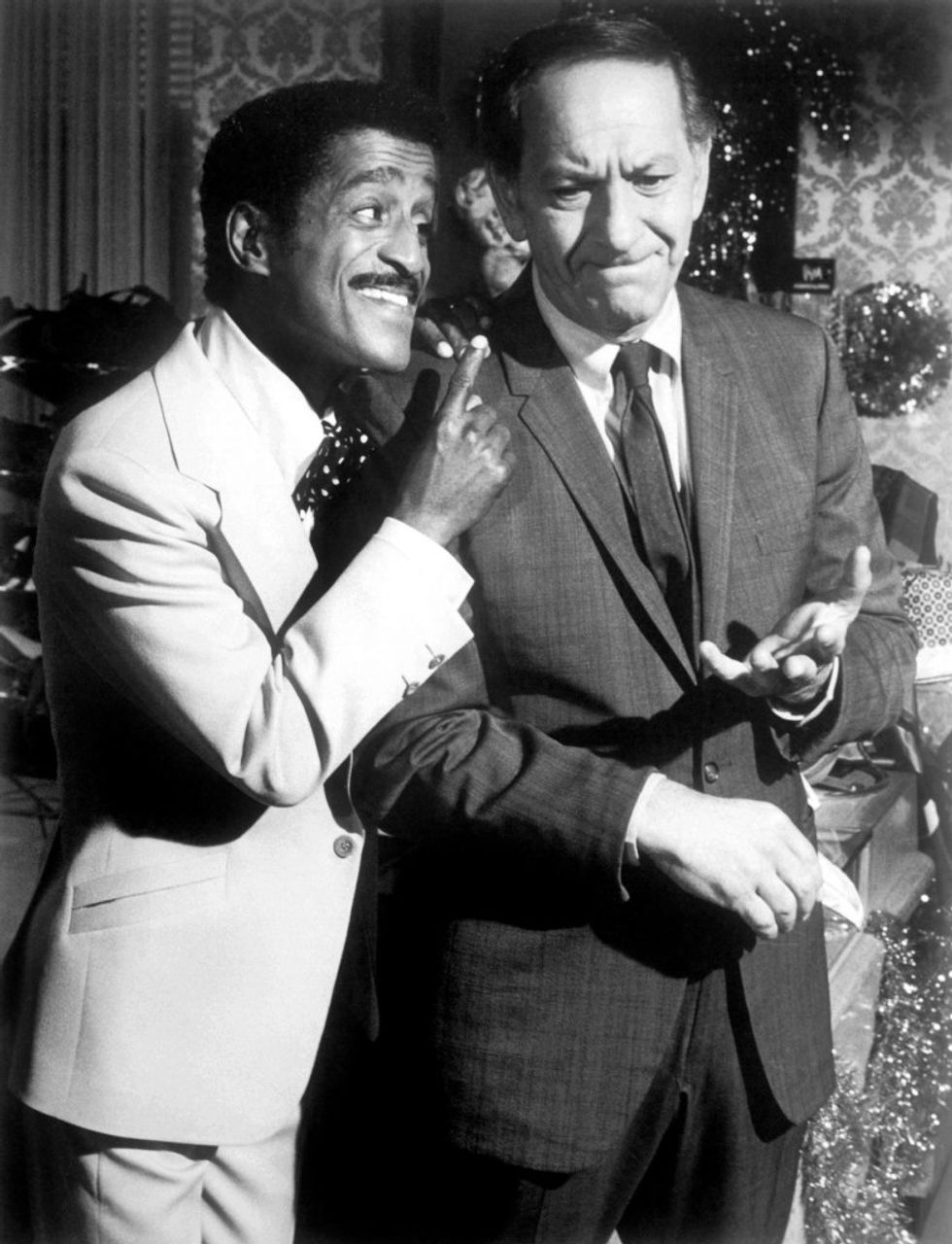
LaVey didn’t need to see the show to appreciate its PR potential. So he, Hegarty, and Aquino hatched a plan. Initially, the aim was to get LaVey screen time and perhaps to have an episode shot at the Black House. Aquino suggested that the high priest of the Church of Satan invite the star of Poor Devil to become an honorary warlock. Hegarty mused, “Wonder what Mr. Davis will think about being a Black, Jewish, Satanic warlock!”
She wouldn’t have to wait long to find out. A letter arrived just a month later:
I would be most happy to accept your honorary membership, and I am pleased to learn that no one was offended by our recent film “Poor Devil.” As I’ll be performing in Vegas at the Sands Hotel from now until April 8th, perhaps you can arrange to present your award to me when I’m at the San Carlos Circle Star Theater during April 10-16. Once again, my thanks.
Peace and love,
Sammy Davis Jr.
DAVIS’ EXPERIENCE WITH Satanism has long lurked in the margins of his story, despite later efforts to excise and minimize it. The reality is that he maintained a two-decade-long connection that extended to the waning days of his life, and forged a friendship with LaVey, the Church of Satan’s leader.
A previously unreported narrative emerges through numerous exclusive interviews — with Davis’ associates and biographers, and LaVey’s friends, followers, and family (including Hegarty; his last companion, Blanche Barton; and his grandson Stanton LaVey). Sharing a need for adoration, the two showmen built a meaningful, if improbable, bond. For Davis, a beloved entertainer who tasted bitter rejection from nearly every quarter, this longing for acceptance drew him to judgment-free Satanism and led him to LaVey, thanks to a peculiar TV pilot.
Poor Devil would never have existed without a bit of Satanic serendipity. When Davis met with the NBC brass in 1972 to discuss projects, he bounced a comedy concept off them — a vague pitch about a guy working for the man downstairs. It’s possible the idea was inspired or informed by Davis’ own experience: In his 1989 autobiography, Why Me?, he would give a lurid account of a night in 1968 when he accepted an impromptu invitation to a heavily ritualized Church of Satan ceremony in the Hollywood Hills that, to his delight, ended in a drug-fueled orgy.
Inchoate as it was, Davis’ idea collided with the concept for another series under consideration at NBC, a comedy with the working title Beat the Devil by two veteran TV writers — Arne Sultan and Barret, who’d made light fare about the dark arts before, on Bewitched. Presented with the possibility of folding his Satanic comedy into Barret and Sultan’s project, Davis was intrigued.
“I love the idea of it,” Davis announced after hearing the writers’ pitch.
Davis saw Poor Devil, as the project was renamed, as an inversion of It’s a Wonderful Life: A bumbling but lovable underling in the afterlife attempts to earn a promotion — only not by saving a good man but by convincing one to sell his soul. Davis clung to this interpretation, Barret would recall: “But it was Faust. It’s about making a deal with the devil.” Actor and writer debated: It’s a Wonderful Life, Faust; feel-good story, morality play. Finally, Barret challenged his star. “But the devil has to lose. Right?” Davis just laughed.
EVEN MORE THAN most performers, Davis was driven and defined by a desperate need for acceptance. On Dec. 8, 1925, in Harlem, Samuel George Davis Jr. was born to two vaudeville performers who divorced when he was just a tot. Sammy Sr. was Black and from North Carolina; Elvera Sanchez was Cuban American (Davis would later pretend she was from Puerto Rico) and, according to family and friends, proclaimed her newborn looked like “a little monkey,” and filled her dark-skinned son’s ears with racist and colorist remarks.
At age three, Davis began performing alongside his father and the longtime vaudevillian Will Mastin, whom he considered an uncle. By four, Davis was dancing and singing in blackface, perfecting the white minstrel-show caricature of Black behavior.
This is a very selfish religion, LaVey said about Satanism. We believe in greed and selfishness.
Touring with the Will Mastin Trio, Davis grew up fast and flashed his prodigious talents. After being drafted in 1943, Davis found the cheers replaced by epithets and blows hurled by white soldiers. They broke his nose repeatedly, permanently flattening the bridge; covered his body in white paint and spelled out the n-word on his chest; and once doused him with urine. Davis played shows at the service club, hoping the ability to entertain would assuage his abusers. “While I was performing,” he would say later, “they suddenly forgot what I was, and there were times when even I could.”
After his discharge, Davis rejoined the Will Mastin Trio and his star skyrocketed. Record contracts, TV appearances, and bigger venues followed. Then, in 1954, a near-fatal car crash left him with a glass eye and started him on a journey of spiritual inquiry. What began with “an awakening” after reading a Scientology book led, more lastingly, into Judaism. When Davis told his Jewish friend Jerry Lewis he had converted, the comedian responded, “You don’t have enough problems already?”
Apparently not. Davis struck up an affair with actress Kim Novak, who was beautiful, and white. Reports of his top star running around with a Black man enraged Harry Cohn, head of Columbia Pictures, who sent Davis a threat: Leave Novak and marry a Black woman, or you’ll lose your other eye. Acquiescing, Davis wed Loray White, a singer he barely knew, in a hot hurry and filed for divorce almost as quickly, without ever living with her.
In 1959, Davis fell for Swedish actress May Britt. When they married the following year, their interracial union, still illegal in 31 states at that time, provoked hate mail and protests by white-supremacist groups.
If Davis believed he would find a safe harbor among his show-business buddies, he was only partly right. In the late Fifties, Davis joined Frank Sinatra and others to form the Rat Pack, which they sometimes called the Clan despite Davis’ discomfort. They regularly jabbed him with racist barbs. Beyond calling Davis “Smokey,” Sinatra quipped that Davis had to smile to be seen in the dark. Dean Martin would scoop Davis in his arms and announce, “I’d like to thank the NAACP for this wonderful trophy.”
Davis’ interracial marriage made him a political pariah, as well. He had been scheduled to perform at John F. Kennedy’s inaugural ball and attend the swearing-in with Britt on his arm. Three days beforehand, however, Kennedy’s personal secretary called: “The president has asked me to tell you that he does not want you to be present at his inauguration.”
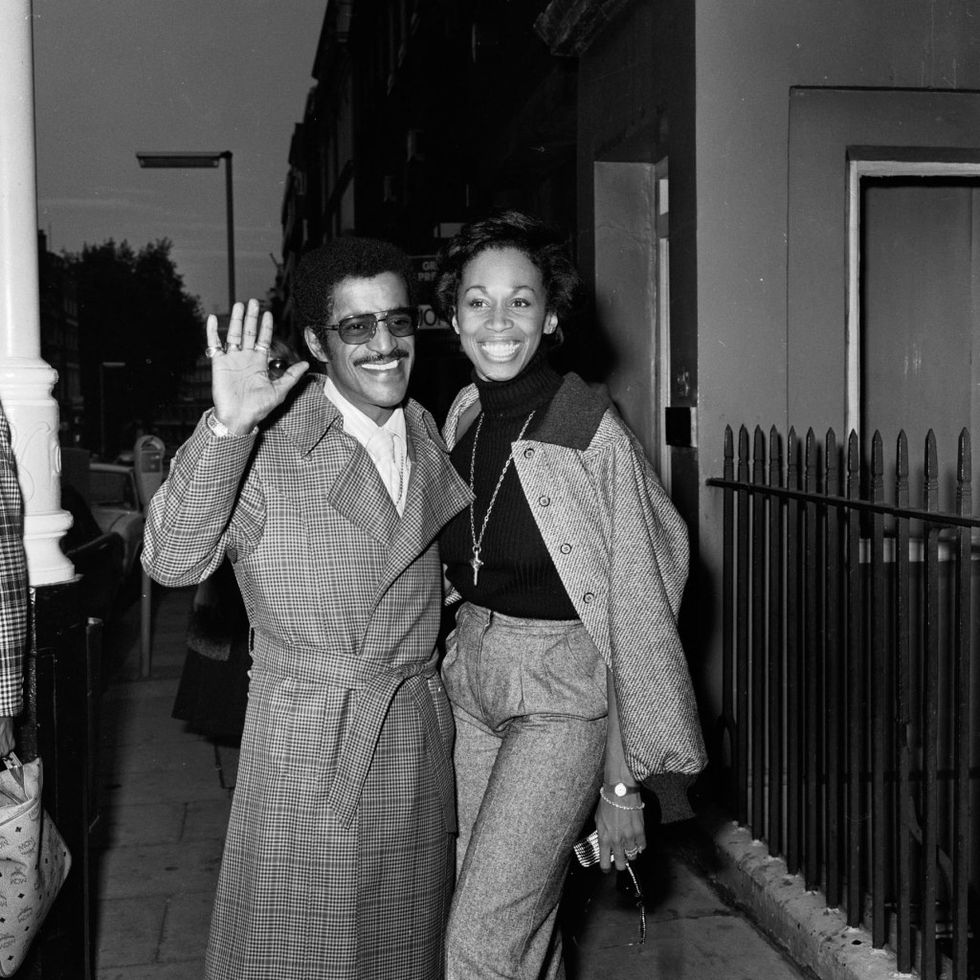
As the Sixties unfolded, Davis was increasingly isolated, too forward for the white establishment, too backward for Black radicals. Though he had joined Martin Luther King Jr. at the March on Washington and in Selma, Alabama, many in the Black Power movement saw Davis as cringeworthy and assimilationist. And he had married a white woman. In response, in the late Sixties, Davis grew his hair into an Afro and dated (and would later marry) a Black dancer turned actress named Altovise Gore. She was bright, beautiful, young, and modern, accepting Davis’ need for an open marriage. “They call you ‘the Carpenter,’” she told Davis, “’cause you nail every girl you meet.”
Davis’ fame would always outstrip his fortunes, and by the beginning of the Seventies, the zeitgeist had left him behind, too. His films flopped; his take on albums was minimal (he wasn’t a songwriter and didn’t own his masters); his audience was aging; the kids, who saw through his act (the designer dashikis and beads), had no interest in his shtick.
Wanting to be wanted, Davis shook free of conventions and orthodoxies — racial, sexual, and political, which led him to drift from the Democrats to the waiting arms of Richard Nixon. At the 1972 Republican Convention, Davis hugged a visibly uncomfortable Tricky Dick, sparking an angry backlash that threatened to destroy Davis’ career.
And so, after a run of guest-starring spots and after authoring a significant cultural moment by planting a shocking, ad-libbed kiss on Archie Bunker on All in the Family, Davis was now pinning his financial hopes on episodic TV and Poor Devil. As he told Barret and Sultan when signing on, “You’re gonna get me residuals.”
Although neither Davis nor his lifestyle ever showed it, he was broke and had been for a while. Since extricating himself from the Will Mastin Trio in the mid-1950s (for a share of future earnings), Davis had been in a downward spiral of revolving debt, using the money from each nightclub contract to buy his way out of the last one. It didn’t help that he was an incorrigible spendthrift. Big paydays, bigger sprees — if he would earn $30,000 for a casino show, he’d gamble away $40,000 at the tables, and so it went. In his career, Davis would earn more than $50 million (and much more off the books), yet upon his death, he would be $15 million in arrears — owing more than $7 million to the IRS, $4 million to Mastin’s estate, nearly $2 million to the state of California, all the way down to unpaid tabs of $1,754 at the Beverly Hills Camera Shop and $523 at the local pharmacy.
“COME FORWARD THOSE who have received the benediction of Satan and the blessings of hell.” Bathed in red light, LaVey wore a black cape and hood affixed with horns. Sword in hand, he beckoned a man in the crowd forward. “And what is your wish?”
Behind LaVey, a naked woman sat on the altar, alternately caressing and slapping the bare bottom of another woman. Over the altar hung the sigil of Baphomet — a goat-headed gnostic idol within a pentagram contained in a circle, and adorned with Hebrew runes. Standing before LaVey, a man in a bowler hat and bow tie proclaimed: “I would like Satan to arouse insatiable desire in the heart of that lovely young bank teller who’s just moved into my neighborhood. He said his name was Roger.”
Laying the sword on the man’s head, LaVey intoned: “Insatiable desire shall follow Roger … and he shall be summoned unto you. And his brute, thrusting fire — the shaft of his flesh — shall permeate the atmosphere and shall be grasped by your eager flesh. And lust shall remain supreme. Roger shall hear this and come to you, in the night henceforth this day shall end. So it shall be. Shemhamforash.” The worshipers repeated after LaVey: Shemhamforash and Hail Satan.
About three years before this ceremony, in early April 1966, Time magazine sent shock waves through American society with a cover that asked “Is God Dead?” Three weeks later, on April 30, LaVey launched the Church of Satan, declared Anno Domini 1966 to be Anno Satanas Year One and himself the high priest.
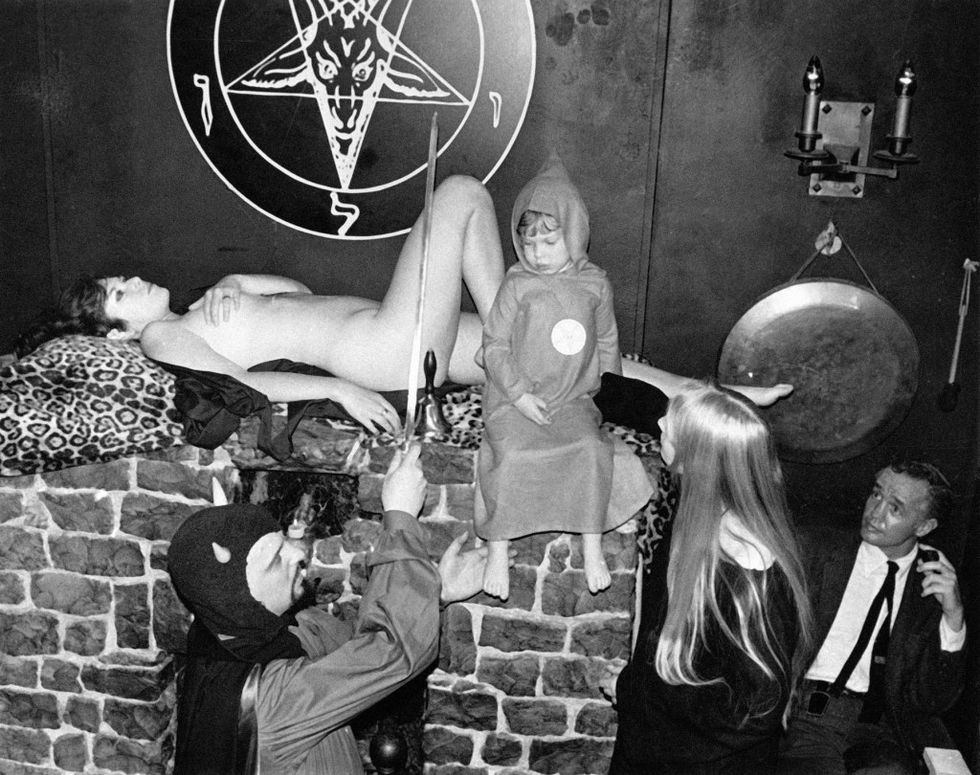
That night, LaVey appeared at the Black House with a newly shaven head, a ritual “in the tradition of medieval executioners,” according to the church’s official history. The bald pate and Mephistophelian goatee evoked Ming the Merciless of the Flash Gordon comics and the menacing devil worshippers from movies — LaVey was reclaiming pop culture’s caricature of a Satanist to fashion his high-priest persona. As the filmmaker Kenneth Anger would say of his friend, “Anton was a showman, and his concept of Satanism was show business.”
His life story was fittingly cinematic. He was born Howard Stanton Levey in Chicago on April 11, 1930, before moving to Northern California with his family. As a boy, he loved horror movies and played multiple musical instruments. At 13 or 14, LaVey revealed to Rolling Stone in 1991, he had a vestigial tail removed without anesthesia.
From there, the facts become murkier. He claimed he ran away to join the circus and learned to tame lions; played organs in clubs and had an affair with a young Marilyn Monroe; and worked as a crime-scene photographer, seeing atrocities that convinced him there was no benevolent God. LaVey had long recoiled from organized religion. As a carnival organist, he would see men lusting after scantily clad girls on Saturday night, and then praying in the pews when he played Sunday-morning tent revivals. “I knew then that the Christian church thrives on hypocrisy,” he told his biographer Burton H. Wolfe, “and that man’s carnal nature will out no matter how much it is purged or scourged by any white-light religion.” In the late 1950s, LaVey formed a magic circle in San Francisco to explore black magic and the occult (the regulars included friends like Anger, the Danish baroness Carin de Plessen, and fantasy/sci-fi writers such as Fritz Leiber and August Derleth, the first publisher of H. P. Lovecraft). As his reputation grew, LaVey searched for a way to bring black magic to more people. By the mid-Sixties, he saw that blasting away two millennia of ignorance and repression required a bona fide religion and a church to invert and refute everything about Christianity.
Free of the traditional concept of sin, LaVey’s Satanism preached living for the day instead of for an afterlife. His most pithy slogan: “‘Evil’ spelled backward is ‘live.’” A close second: “There is a beast in man that should be exercised, not exorcised.” Only by releasing your urges could you be free. “Since worship of fleshly things produces pleasure,” he said, “there would then be a temple of glorious indulgence.”
Those who saw LaVey’s Church of Satan as nothing more than deus sex machina missed its philosophical underpinnings, which drew inspiration from Carl Jung, Ayn Rand, and Aleister Crowley, among others. Not all of it was pretty — LaVey embraced social Darwinism, for instance — but that was the point: Satanism doesn’t shy away from the baseness of human nature. “This is a very selfish religion,” LaVey said. “We believe in greed; we believe in selfishness.”
Within six months of the church’s founding, the Black House had become a destination for seekers from the counterculture and establishment alike. The most famous among them was Hollywood star Jayne Mansfield, who LaVey ordained. The blond bombshell then initiated a provocative Satanic photo shoot and maybe an affair with LaVey. The Black Pope had put a curse on Mansfield’s boyfriend, prophesizing his romantic rival would die in a car crash within a year. Eight months later, in June 1967, Mansfield, her beau, and the driver were killed when their car slammed into a stalled tractor-trailer, peeling the top of the vehicle off like a can of sardines. Headlines announcing the Hollywood star had been decapitated were only slightly hyperbolic.
By 1968, no one was having a bigger year than the Great Temptor. Months after releasing Their Satanic Majesties Request, the Rolling Stones recorded the primal epic “Sympathy for the Devil.” As roiling anger replaced flowery images of the Summer of Love, devil worship, long a B-movie trope, moved to the A list with the Roman Polanski film Rosemary’s Baby. In the pivotal scene, Mia Farrow is raped and impregnated by Satan as his followers chant expectantly. According to legend he himself helped spread, the man inside the hairy demonic suit was none other than LaVey.
It was against this backdrop that same year that a group of young actors Davis met at a Hollywood nightclub brought him to a Satanic ceremony, apparently his first. A hooded priest began the benediction by picking up a rubber phallus and inserting it into a naked woman lying atop the altar. “It was all fun and games and dungeons and dragons and debauchery,” Davis later wrote, “and as long as the chick was happy and wasn’t really going to get anything sharper than a dildo stuck into her, I wasn’t going to walk away from it.”
Anton was a showman, and his concept of Satanism was show business, says Kenneth Anger.
LaVey had distilled Satanism into nine statements — not commandments (Satan would never tell you what to do). The first: “Satan represents indulgence, instead of abstinence!” Hand in hand came a complete live-and-let-live acceptance, regardless of the impulses released — hedonistic, ambitious, vengeful, whatever.
And this — the hedonism, sure, but the radical acceptance — was undoubtedly the key to Davis’ interest in LaVey and the Church of Satan. For someone who needed acceptance and affirmation, the contrast was stark, black and white. Disrespected, and disinvited by the Democrats. Opportunistically embraced by Republicans. Jeered and shunned by Black activists. And then there were the Satanists — who welcomed him into their sanctum without judgment.
IN SCHEDULING A date for Davis’ ordainment into the Church of Satan, LaVey found a bit of good fortune: One of Davis’ Bay Area concert dates was April 13, 1973, a Friday. So on Friday the 13th, LaVey dispatched Aquino and Karla, his daughter from his first marriage, to the Circle Star Theater, named for its round, rotating stage. Davis’ suggestion that he be made a warlock there was loaded with uncanny symbolism. “Anton and I loved the idea,” Hegarty recalls, “because the circle and star — the pentagram — was part of our Baphomet sigil.”
Despite his love of the spotlight, the high priest opted to hang back, a calculated effort to play it cool. “The less we push,” he had written to Aquino, “the better Mr. Davis’ opinion of us will be.”
As LaVey’s proxies quickly learned, the performer’s opinion of the Church of Satan was already high and Davis welcomed them warmly.
Amid the good feelings, Davis took his ordainment certificate and bowed his neck to receive a medallion that, on closer inspection, was the Baphomet sigil.
An audience of 3,700 watched as he took the stage wearing his new pendant.
Then, with the Baphomet sigil bouncing on his chest, Sammy Davis Jr., the Church of Satan’s newest warlock, second class, closed the performance with his anthem, a cri de coeur echoing the essence of LaVey’s Satanism:
“Whether I’m right or whether I’m wrong,
Whether I find a place in this world or never belong,
I gotta be me, I’ve gotta be me.…”
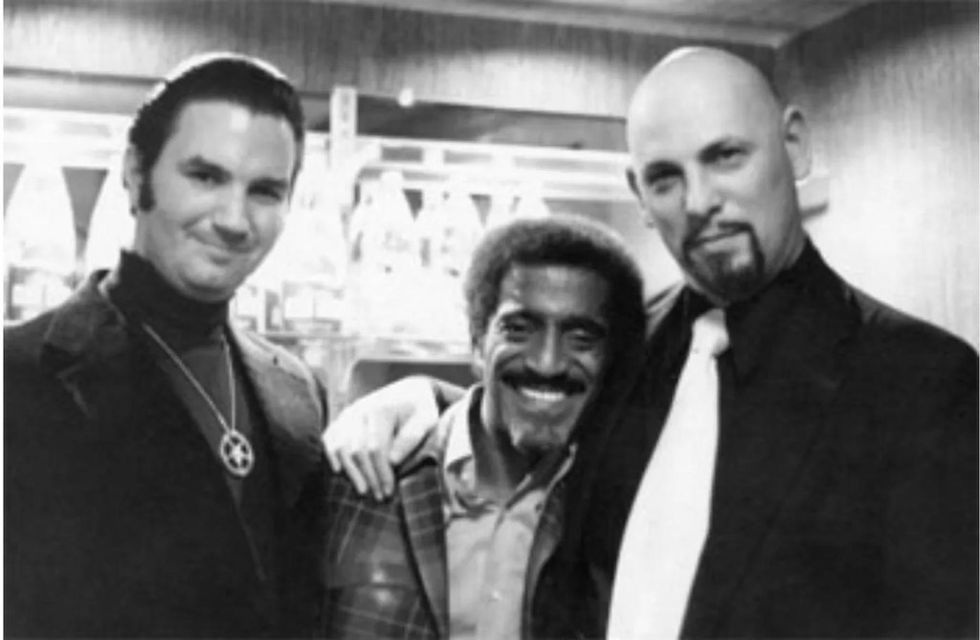
THE CAR STOPPED in front of 1151 Summit Drive in Beverly Hills, and LaVey and Hegarty got out. They peeked through the privacy hedges, straining for a glimpse of the statuary-topped fountain and the arched balcony on the facade of Davis’ mansion. LaVey and Hegarty never approached the gate, much less passed through. Their impromptu visit just a few weeks after the ceremony at the Circle Star had caught the security guard’s attention. Eager to meet the famous new warlock himself, but wary of being seen as a stalker, LaVey retreated and wrote Davis a jaunty letter instead:
Next time you are in the San Francisco area, perhaps we can unlock the old Church of Satan headquarters (we’ve had to literally fortify it from curiosity seekers) and give you a cook’s tour, so to speak. My wife and I spend a good deal of time in the L.A. area and are quite familiar with Summit Drive; in fact, we recently inspected the old Barrymore place, which, as you probably know, is presently up for sale. On our return we drove by your address and were sorely tempted to announce ourselves to your pleasant young sentry, but, protocol taking precedence, moved on. It is an honor having you with us; your avowed code of living is about as Satanic as one could find….
My most Infernal blessings for your continued triumphs!
If the real reason for the note was to land an invitation, it worked. Only a few months later, in August 1973, Davis opened his door and hugged them as if they were old friends. “Hey, Diane! Hey, Anton!” he said, then called into the house: “Hey, Altovise.”
LaVey and Hegarty knew Davis from his public persona, but this was their first time laying eyes on his wife. Altovise was beautiful, bright-eyed, and nearly a head taller than her husband. She first met Davis as a backup dancer — a role she would play until the end of their lives, and after (she would be buried beside Davis in an unmarked grave). Altovise seemed content to let him lead this gathering as well.
Davis had also invited a pair of alluring young witches, hoping to spice up the night. “Sammy was experimental,” Hegarty would later say. “He was game for anything.” Sex, substances, Satanism — they fed Davis’ hunger for experiences. “He saw the sexual freedom the church supported, and that got him interested.” But swinging was not these Satanists’ thing: “We didn’t engage in any orgiastic activities.” It was one of LaVey’s great contradictions that he dedicated himself to helping others unleash their urges while obsessively maintaining control over his own.
For Davis, nights with the first family of Satanism represented rare moments of moderation. For decades, his drink had been bourbon and Coke. Now, he paired jiggers of whiskey from behind his bar with bumps of coke from the silver bowl he kept atop it. LaVey didn’t judge drug users — judgment is the enemy — but he believed the best way to unshackle yourself from society’s repression is with a clear mind.
There would always be a crowd, Lorna Luft said about Davis’ house. All night doing cocaine … partying.
That first night — as on others — LaVey and Davis spent long hours discussing the tenets of Satanism. Although LaVey and Hegarty had been disappointed to learn that NBC had canceled Poor Devil, their mood soared as they discovered Davis was both experienced with Satanism and informed about its finer points. Departing at the end of the evening, the high priest was elated and gushed about his new warlock’s commitment.
Over the next several years, Davis extended a series of invitations to LaVey and Hegarty — to intimate dinners, larger parties, shows, and his home near Lake Tahoe. On their first visit, Hegarty recalls, LaVey was struck by a pleasant surprise when his host showed him the master bedroom: there, hanging in a place of honor, was the Baphomet sigil bestowed upon Davis at his ordainment.
Davis sometimes flirted with Hegarty. Once, when she mentioned she had gained a little weight, he spun her around and said, “Oh, and I might add, in all the right places.”
Davis’ wandering eye didn’t inflame LaVey’s jealousy, except when it landed on Lucifer from Poor Devil, Christopher Lee. Thinking the occult expert cum horror star and the high priest would be simpatico, Davis hosted a dinner party that went off the rails. Insecure about Lee’s closeness with Davis and irritated by his priggish manner, LaVey started a heated argument with the actor, ostensibly over who was the best Dracula — Lee or Bela Lugosi. Soon, Davis had to step between his two towering guests to prevent them from coming to blows.
On most nights the couples were together, however, Davis was the one to push boundaries. Once, he brought out a selection of adult films. “I thought, ‘He must think we’re into this,’” Hegarty recalls. “We weren’t prudes. We’d seen porn films. But that wasn’t what we would haul out at a moment’s notice. Just wasn’t our style.”
Davis, on the other hand, regularly invited Deep Throat star Linda Lovelace and her husband-handler-abuser, Chuck Traynor, to Summit Drive. With Traynor’s blessing, Davis began an affair with Lovelace. One night, Davis sought the porn star’s guidance in performing her signature deep throat, which he practiced on an unsuspecting Traynor.
Among friends, Davis was open about the fact he’d had encounters with men, according to his biographer and Paul Anka, who discussed Davis’ sexuality in his memoir. Coming out was never a consideration, especially as bisexual. Davis saw things as black or white, gay or straight.
“The greatest turn-on I’ve ever experienced was watching a gay film,” Davis told porn star Marilyn Chambers in the adult magazine Genesis. “I couldn’t deal with it. Maybe it’s my own latent feeling about homosexuality that I can’t deal with.… I have this image as a stud, and you can’t be a stud and a homosexual at the same time.”
To the extent he understood Davis’ fluid sexuality, LaVey was accepting. Radical, absolute tolerance was central to LaVey’s Satanism. Still, it was hardly touchy-feely — a me-first ideology that encouraged unbridled individual freedom and the pursuit of personal power.
LaVey’s acceptance was a revelation for Davis. More than anything, it explains their friendship.
It was kindled at a time of personal crisis for Davis, in the aftermath of his embrace of Nixon at the 1972 RNC. The chorus of younger Black activists who’d called Davis an Uncle Tom before was joined by mainstream civil rights leaders. To try to quell the controversy, Davis agreed to perform at the Black Expo, organized by his friend Jesse Jackson. Davis walked onstage to boos.
“Disagree, if you will, with my politics,” he said, eliciting more derision. “But I will not allow anyone to take away the fact that I am Black.” Raising the mic, he began singing, his voice more angry than apologetic: “Whether I’m right or whether I’m wrong/Whether I find a place in this world or never belong/I gotta be me.…”
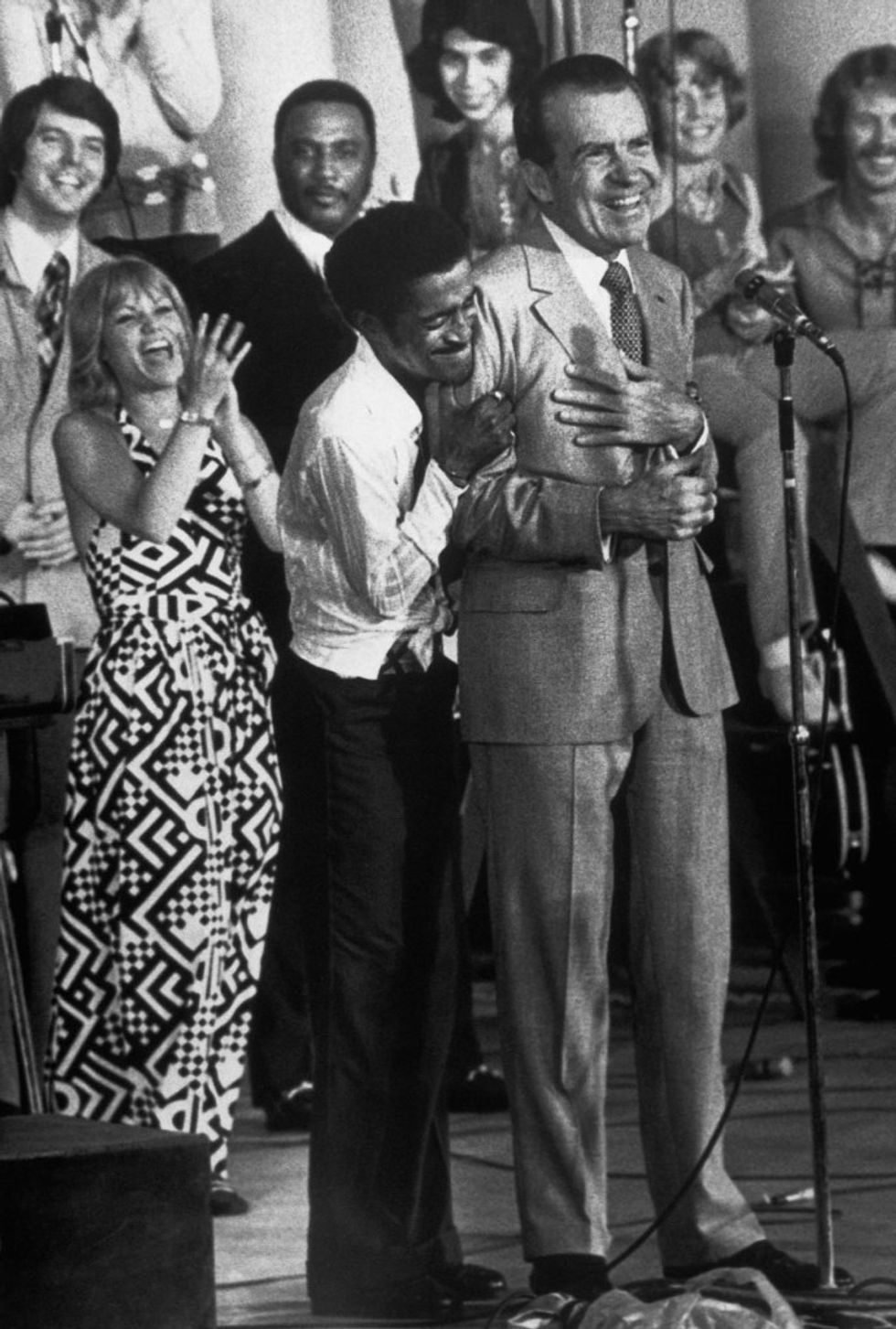
“I wish I had a goddamn film of me marching in Selma, in Tougaloo,” Davis ranted in The New York Times soon after. “I was on the Klan’s 10 Most Wanted list.… Now I’m being hassled by other blacks, I’m being called an Uncle Tom.”
Partway through, the interview takes a dogleg turn as Davis announces to the paper of record that he’d recently attended a Satanic Black Mass. “I respect the people involved in the black arts — they aren’t to be messed with,” he added. “Shakespeare said there are more things in heaven and on Earth than we suspect — all that jazz.” Although his meeting with LaVey was still months away, in LaVey’s church, Davis had already found a community accepting of him and all his contradictions.
Once they connected, Davis and LaVey quickly forged a bond that extended beyond Satanist theory. In one of their secret adventures in Las Vegas, the friends romped with Marilyn Chambers and vied to see the other in flagrante. Through the mid-Seventies, LaVey sent Davis letters and books on the occult with an affectionate sign-off — “Infernally Yours,” with swirling Y’s pointed like a devil’s tail. The two shared a nickname for Satan: Old Slew Foot, a colonial-era sobriquet for the cloven-hoofed devil that spoke to the legendary tap and soft-shoe performer.
For his part, Davis made a show of heartfelt gestures. In the spring of 1974, he invited LaVey, Hegarty, and Aquino for a reunion at the Circle Star. When someone broke out a camera, Davis smiled broadly in his plaid sports coat and rested his head against LaVey, who could barely restrain a smile. As the photographs — the only known pictures of LaVey and Davis — show, the pair fit together well, connected symbiotically: LaVey feeding Davis’ need for acceptance and recognition, and Davis, in turn, delivering credibility through the glow of celebrity. After the concert, at his hotel, Davis presented the trio with 18-karat gold bracelets, signifying, he said, that they were his “personal family.”
In response, LaVey surprised everyone by proposing that Davis eventually step into a new long-term role with the Church of Satan: the senior official overseeing all of North America. “Retrospectively, it is difficult to say how Diane or Sammy or I might have reacted logically to such visions,” Aquino would write, “but it was a night for magic, not logic.”
“I HOPE YOU folks at home had fun,” Davis said, signing off an early episode of Sammy & Company. “’Cause what we intend to do … is let you into my world a little bit.”
The talk show, which premiered in April 1975, did that in unintended ways. Even artful editing couldn’t hide the fact Davis often appeared incoherent and high. Critics savaged it, and it was consigned to the late-night-Sunday graveyard. Coming on the heels of Davis’ widely panned performance hosting the Oscars alongside Sinatra and Shirley MacLaine, the show was a weekly reminder that 1975 was shaping up to be a rough year.
Beyond a fast-declining career, Davis was forced to confront his mortality. In September, he was hospitalized for a week with pain in his limbs — he’d earlier been admitted with chest pains. He began canceling shows and often required nights off after a performance. His nightclub and casino bookings faltered.
The only thing that seemed to lift his spirits was the thing dragging him down: partying. Altovise planned an elaborate 50th-birthday bash, a salve for the sting of aging, and an upbeat end to Davis’ annus horribilis.
Gliding through his house, Davis greeted one guest after another, all dressed in children’s clothes — the theme for this costume party. The revelers couldn’t miss the birthday boy’s cheeky outfit: a tiny pair of kids’ pajamas. Towering over the crowd with his shaven head, LaVey couldn’t help but stand out. His daily regalia — black suit usually with cape — was like a kid’s costume: a child’s idea of how Dracula or a Satanist would dress.
LaVey, the ultimate outsider, was finally an insider. He’d been busy selling Satanism and himself in Hollywood, serving as a technical consultant on Svengali the Magician (rereleased as Lucifer’s Women) and landing a similar gig on 1975’s Devil’s Rain. Once on set, LaVey talked his way into a speaking part as “the high priest,” alongside Ernest Borgnine, William Shatner, and John Travolta. Now, LaVey was on Summit Drive, mingling with music-industry machers, Hollywood heavies, and Davis’ nearest and dearest. He was one of them.
The birthday bash was an opportunity for LaVey, like Davis, to forget about 1975. Anno Satanas 10 had seen the Church of Satan split in two. Although LaVey still received visitors at the Black House, their numbers began dwindling, and they found the high priest subdued and introspective. One caller, at last, was Davis, who visited a few times for low-key nights, with the high priest holding forth and playing the organ.
By contrast, Davis’ house on Summit Drive was still one of the highest spots in town. “There would always be a crowd,” Judy Garland’s daughter Lorna Luft recalled in her memoir. “Most of us would be up all night doing cocaine and partying our brains out.” Along with the partying, there was sex: According to Kathy McKee, a showgirl who was one of Davis’ girlfriends in the 1970s, “Sex was always preceded by cocaine.” Davis, McKee would write, traveled with a vanity case full of coke and poppers. “This gave a new meaning to Sammy’s reputation as ‘the Candy Man.’”
I became a Satanist, read an excised portion of Davis’ memoir. I became fascinated by their philosophy.
And the effects of his substance use were on increasingly public display: Davis often left the stage after two or three songs, thinking he’d finished the show. On one self-aware occasion, he announced, “Well, folks, some nights I have it and some nights I don’t have it. Tonight I don’t have it.” When Davis did make it through a performance, he no longer closed with the proudly defiant “I Gotta Be Me” but with the melancholy “Mr. Bojangles” — the story of a homeless vaudeville performer dancing for drinks and tips in his last days. If the tap shoe fits …
As the 1970s passed and Davis’ social life increasingly revolved around booze and drugs, Sinatra couldn’t bear to see his old friend so dissipated, and cut off contact. First through intermediaries, then face to face, Old Blue Eyes told Davis to get his act together. He was especially horrified that his close friend was fraternizing with Satanists.
It’s impossible to say how much this disapproval from a parental figure like Sinatra caused Davis to reconsider socializing with LaVey. It’s also unclear whether LaVey knew the extent of his friend’s addictions or, if he did, whether he tried to help.
What is clear is that the fellowship between Davis and LaVey gradually waned in the late Seventies. For a while, at least, the two spoke on the phone. But Mr. Show Business and the Black Pope met less frequently and eventually stopped altogether. The friends who bonded over cloven-hoofed Old Slew Foot were never cleaved in two. They simply drifted back into their respective orbits.
I became a Satanist. I was introduced to some very interesting people, including the head of the Satanist Church in the States, and became fascinated by their philosophy. I actually joined the Church to find out what I could about their beliefs.… I still have many friends in the Church of Satan.… People who can put up an interesting case will often find I’m a willing convert.
This excerpt from Davis’ 1980 memoir, Hollywood in a Suitcase, ran in the New York Daily News with the subtitle “A Touch of Satanism and Lessons in Love.” Yet when the book was published, it was nowhere to be found, excised completely. Someone, maybe everyone, including Davis, had gotten cold feet.
It was not the Seventies anymore.
The dawn of the 1980s saw the rise of the Satanic Panic. Although debunked, accusations of human sacrifice, infanticide, and sexual abuse fueled paranoia across America.
In 1988, NBC aired Geraldo Rivera’s special report Devil Worship: Exposing Satan’s Underground, which finally delivered the ratings bonanza Poor Devil never could. Sensationalist coverage that once put LaVey in the spotlight now put him in the crosshairs. Faced with death threats, the high priest holed up inside the Black House’s walls, which were occasionally peppered with gunfire.
THE TV GUIDE ARRIVED at the Church of Satan headquarters as usual in early February 1990, but Diane Hegarty was not there to circle programs of interest as she’d done with Poor Devil. Hegarty and LaVey separated in 1984, after, she claimed (and he denied), he had become angry and violent. Instead, LaVey’s last partner, Blanche Barton, shared the Black House with the Black Pope. Although she had never met Davis, Barton couldn’t have missed the Church of Satan’s most famous warlock on the TV Guide cover.
In early 1989, doctors diagnosed Davis with throat cancer, forcing him to give up his act. Sensing the end was near, Davis’ handlers began arranging a tribute show. Dubious that Davis would see his 65th birthday, they decided to commemorate his 60 years in show business.
In a coup, Eddie Murphy, Hollywood’s biggest star, agreed to emcee the affair. He revered Davis, who loved to be loved. One night, under the chianti-bottle chandeliers of Dan Tana’s in Hollywood, Davis started to give the young comedian his confession. “You know,” he said, “Satan is as powerful as God.…”
Met with Murphy’s “What the fuck are you talking about?” and incredulous silence, Davis showed that he could still read the room — and he lightened up. But he never let go. According to friends, Davis continued to perform Satanic rituals into his final days. His girlfriend Kathy McKee had broken off their affair due to them. “Lovemaking,” she wrote, “became a ritual tied into the worship of the occult in ways I didn’t want to understand.”
Apparently, Davis found others who did, participating in Satanic rites with sexual partners through the 1980s. One associate wrote to Altovise that during these carnal revelries, Davis would draw blood with sharp objects, including broken bottles, sometimes from the private parts.
It’s hard to know precisely when or why Davis’ practice of Satanism took this seemingly dark turn. Perhaps it was a reaction to aging, career stagnation, and looming financial ruin. Or maybe a release for deeper-rooted rage. Or simply a sadomasochistic fetish.
LaVey had no idea of Davis’ enduring devotion to Satanism as he watched the Sammy Davis Jr. 60th Anniversary Celebration. In almost every sense, the star-filled event was a living funeral. A parade of friends toasted (Sinatra) and roasted (Martin) him. President George H.W. Bush sent a recorded tribute from the White House. The Rev. Jesse Jackson eulogized Davis, praising him for opening the door for future generations. The King of Pop, Michael Jackson, performed a newly penned tribute song.
Surrounded by his menagerie of occult oddities and his memories, LaVey looked on as his onetime friend and acolyte stepped onstage at the end of the program and greeted the assembled all-star celebrants, some for the last time, to express his gratitude. Davis never managed that with LaVey, a lament the high priest would carry until his death in 1997. Instead, LaVey watched as the greatest living performer and most famous Satanist blew a kiss to the camera, and the screen faded to black.By the time the show claimed an Emmy for Outstanding Variety, Music or Comedy Special, Davis had been interred at Forest Lawn Memorial Park, where his headstone bears the entendre-laden epitaph: “The Entertainer”: He did it all.
